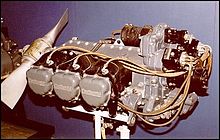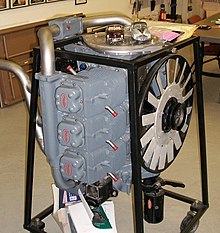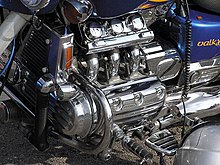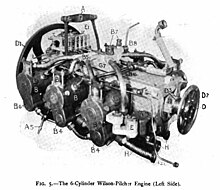Flat-six engine

A flat-six engine, also known as a horizontally opposed-six, is a six-cylinder piston engine with three cylinders on each side of a central crankshaft. The most common type of flat-six engine is the boxer-six engine, where each pair of opposed cylinders moves inwards and outwards at the same time.
The advantages of the flat-six layout are good engine balance (for reduced vibration), a low center of gravity, short length (compared with an inline-six engine) and being well suited to air-cooling. The disadvantages are a large width (which can limit the maximum steering angle when used in a front-engined car), a large intake manifold being required when a central carburetor is used, and duplication of the inlet and outlet connections for water-cooled engines.[1]
The first production flat-six engine was in the 1904 Wilson-Pilcher 18/24 HP car. The most notable use of flat-six engines is the Porsche 911 sports car, which has used flat-six engines continuously since 1963. Several other car manufacturers, including Subaru, have produced flat-six engines at times. Flat-six engines have also occasionally been used in aircraft and motorcycles.
Engine balance
A boxer-style flat-six engine is able to have perfect primary and secondary balance. As per other six-cylinder engines, the overlapping power strokes of the cylinders (with a firing interval of 120 degrees in a four-stroke engine) reduces the pulsating power delivery seen on engines with fewer cylinders. Also, when used in a boxer configuration, a flat-six engine does not have the rocking couple that is present on flat-four engines.[2]
These characteristics result in low vibration for flat-six engines (as per straight-six engines), especially when compared with the imbalances that are present in V6 engines with a 90-degree bank angle.
Use in aircraft

Early flat-six engines include the Franklin O-265 which began production in 1940, and the Lycoming O-435 which began production in 1942. Several manufacturers use the letter "O" in the model code for flat-six engines, as an abbreviation for the opposed cylinder layout. The Franklin O-335 was used in the Bell 47 light helicopter.
Flat engines largely replaced the historically more popular radial engines in small aircraft after World War II because they were less expensive to manufacture. The smaller frontal area compared with a radial engine also results in less drag.
Some aircraft have used flat-six engines originally designed for cars. The Porsche PFM 3200 engine, produced from 1985-1991, was based on the engine used in the Porsche 911 sports car. Several examples of the Pietenpol Air Camper homebuilt monoplane aircraft have used the air-cooled engine from the Chevrolet Corvair compact car.[3] Compared with the engines used in cars, flat-six engines used by helicopters have large displacements and are low revving, producing more torque and less power.[4]
Use in automobiles
Porsche

The flat-six engine is often associated with the Porsche 911, a rear-engined sports car which has used flat-six engines exclusively since 1963. The engines were air-cooled until the 1999, when Porsche started using water-cooled engines.[5]
Other Porsche models to use flat-six engines are the 1970-1972 Porsche 914/6 (mid-engine), the 1986-1993 Porsche 959 (rear-engine), and the 1996-2016 Porsche Boxster/Cayman (mid-engine).
Other manufacturers
The first car to use a flat-six engine was the 1904–1907 Wilson-Pilcher 18/24 HP,[6] which used an engine based on a flat-four engine with two cylinders added. The Wilson-Pilcher was a front-engined car with the crankshaft in-line with the chassis and the cylinders between the chassis rails. Reports on this car quote it as being "remarkably silent and smooth running" and "almost total absence of vibration".[7]
Two American manufacturers briefly produced cars with flat-six engines— the 1948 Tucker 48 (water-cooled) and the 1959-1969 Chevrolet Corvair (air-cooled).[8] Both are rear-engined cars with rear-wheel drive.
Japanese manufacturer Subaru produced water-cooled flat-6 engines from 1988–1996 and 2001–2019.[9] Their first flat-6 engine, the Subaru ER27, was added to the model range of the Subaru XT coupe. In 1991, the Subaru EG33 engine was used in the Subaru Alcyone SVX, the replacement for the Subaru XT.[10] Following a hiatus of flat-6 engine production for four years, the Subaru EZ30 engine was introduced in the 2000 Subaru Legacy/Outback. The Subaru EZ36 engine was introduced in 2007 and was produced until 2019. All engines were used in front-engine cars with all-wheel drive, plus the XT and Alcyone SVX were also available with front-wheel drive.
Use in motorcycles

Most motorcycles use engines with four or fewer cylinders, however the Honda Gold Wing touring motorcycle has used a water-cooled flat-six engine since 1987.[11] Initially, the engine had a displacement of 1.5 L (92 cu in), until it was enlarged to 1.8 L (110 cu in) in 2001.[12]: 208
The Honda Valkyrie F6C (1997–2003) was a cruiser based on the GL1500 Gold Wing.[12]: 198, 218 The limited edition 2004 Valkyrie Rune was based on the GL1800.[12]: 218, 220
See also
References
- ^ Nunney, M J (2007). Light and Heavy Vehicle Technology. Butterworth-Heinemann. p. 13. ISBN 978-0-7506-8037-0. Retrieved 24 September 2019.
- ^ "The Physics of: Engine Cylinder-Bank Angles". www.caranddriver.com. Retrieved 9 September 2019.
- ^ "Pietenpol Official Pietenpol Air Camper Family Website". community.pressenter.net. Pietenpol Aircraft Company. Retrieved May 6, 2017.
As the years passed, Bernard Pietenpol taught himself how to repair televisions and radios. By 1960, Chevrolet introduced the six cylinder air-cooled Chevrolet Corvair. This would be the last engine Bernard would experiment with in powering his Air Camper. In 1966 Bernard completed his first Corvair powered Air Camper, then another in 1970 which was dubbed "the Last Original".
- ^ "The Lycoming O-540 Engine and Why We Use It". www.hieldsaviation.co.uk. 18 November 2015. Retrieved 10 September 2019.
- ^ "Flat Sixy: The Evolution of Porsche 911 Engine Size, Technology, and Output in the U.S." www.caranddriver.com. 13 December 2013. Retrieved 21 September 2019.
- ^ "7 Flat-Six-Powered Vehicles That Aren't Porsches". www.carthrottle.com. Retrieved 21 September 2019.
- ^ "The Wilson-Pilcher Petrol Cars", The Automotor Journal, April 16th, 1904, pp. 463-468
- ^ "Corvair History". www.corvair.org. Archived from the original on 22 June 2014.
- ^ "Flat-6 Club: 1993 Subaru Impreza w/ Legacy 6-Cyl". www.dailyturismo.com. Retrieved 21 September 2019.
- ^ "Subaru history in the USA: the models, the changes". www.cars101.com. Retrieved 23 September 2019.
- ^ "Touring". www.honda.com. Retrieved 23 September 2019.
- ^ a b c Mitchel, Doug (2005). Honda Motorcycles: Everything You Need to Know About Every Honda Motorcycle Ever Built. Krause Publications. ISBN 9780873499668.
{{cite book}}: Invalid|ref=harv(help)



